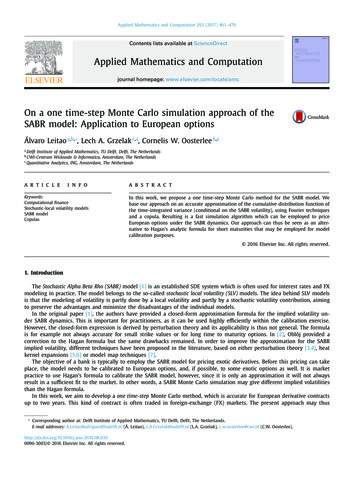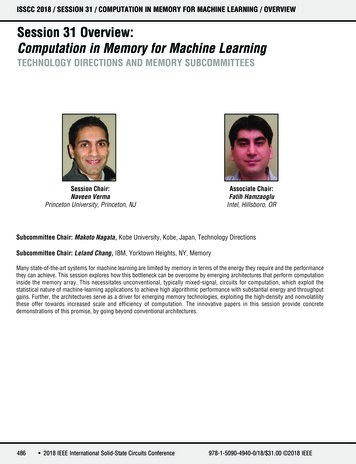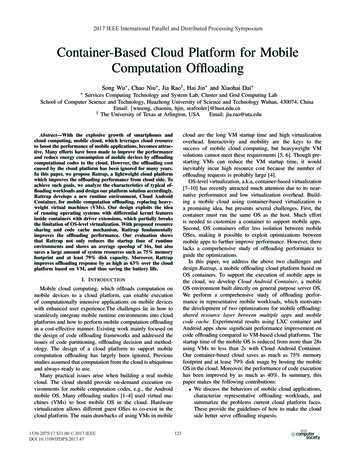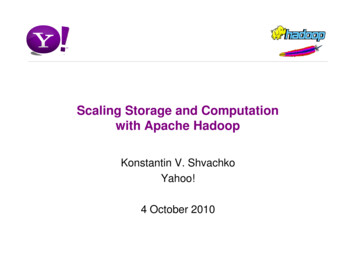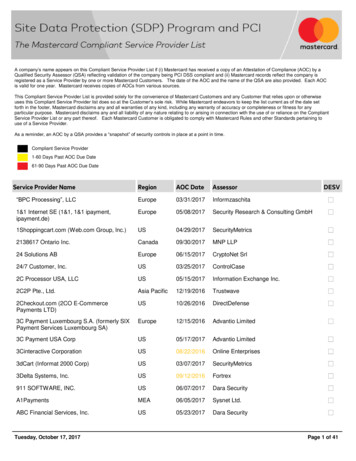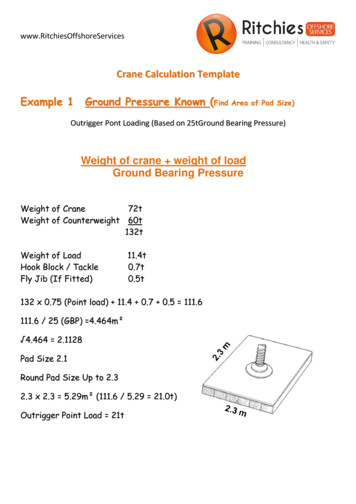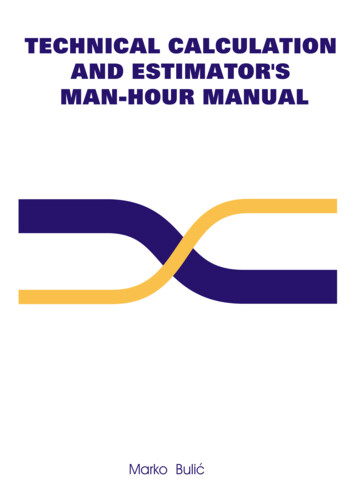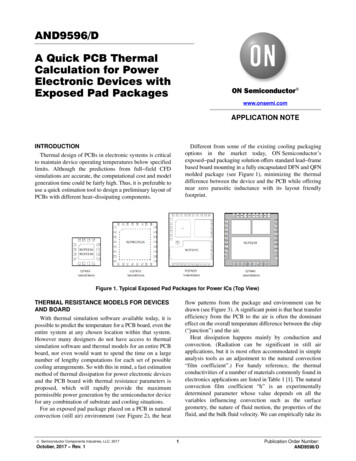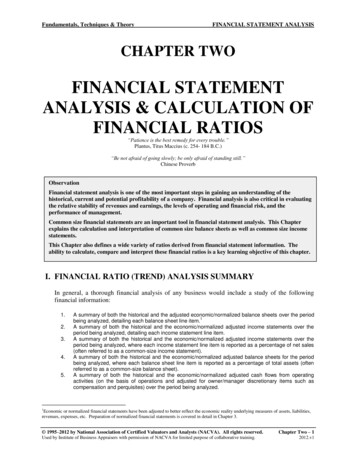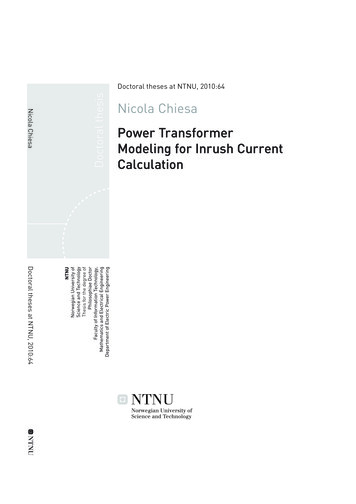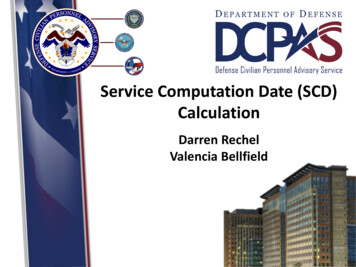
Transcription
Service Computation Date (SCD)CalculationDarren RechelValencia Bellfield
Objectives12State the purpose for SCDsDescribe the basic method forcomputing SCDsCalculate SCDs involving:345Prior service periodsBreaks in serviceExcess leave without pay4
References Title 5, United States Code,Chapter 83/84 CSRS/FERSTitle 5, Code of Federal Regulations,Parts 1603.3; 351.503 & 351.504CSRS and FERS Handbook,Chapter 20 & 22Guide to Processing Personnel Actions,Chapter 6
IntroductionMany benefits that Federalemployees receive are linked tothe amount of time they have beenemployed. SCD is a method used asa standard way to determineeligibility for these benefits
SCD DefinitionA date, either actual orconstructed, used to determinebenefits, which are generally basedon how long the employee hasworked for the Federalgovernment.
4 Types of SCDsReduction-in-ForceUsed to determine who getsdemoted or separatedduring a RIFLeaveUsed to determine rates atwhich annual leave is earnedAn employeemay have 4SCDsRetirementUsed to determine eligibilityfor retirementThrift Savings PlanUsed to determine eligibilityfor TSP vesting (FERS ONLY)
Actual and Constructed SCDsActualIf the employee hasno prior creditableservice at time ofappointment, all 4SCDs are the same asthe calendar date onwhich the employeeis appointed.To construct the SCDyou must have allprior Federal service.ConstructedA rehired employeewho has priorcreditable and/ormilitary service willhave a recomputedSCD referred to as aconstructed SCD
Adding and Subtracting Dates
Adding and Subtracting DatesConvert the dates to a year-month-day format.Rule Number 1Date to convert From:Converts to:Rule Number 2Subtract the beginning date from the ending date.Ending date2007 – 10 – 31Beginning date- 2004 – 05 – 303 – 05 – 01Rule Number 3June 14, 20072007 – 06 – 14ALWAYS Add one day to the ending date, unlessending date is the 31st of the month.Do you need to add a day if the ending date is2009-04-30?
Adding and Subtracting DatesIf the ending date is the last day of February,make it February 30, then add a day.Rule Number 4Rule Number 5February 28th converts to February 30th 1 February 31st (for computation purposes)If the beginning date is the 31st of the month,change it to the 30thEnding dateBeginning dateEXAMPLE2007 – 02 – 28- 2004 – 01 – 312007 – 02 – 30 1- 2004 – 01 – 3003 – 01 – 01 3 years, 1 month and 1 day
Adding and Subtracting DatesWhat is the amount of service fromMarch 18, 1995, through September 18, 1996?Apply the rules:Rules Applied: Convert the dates to Y-M-Dformat Add a day to the endingdate Subtract the beginning datefrom the ending date3/18/1995, becomes 1995 – 03 – 189/18/1996, becomes 1996 – 09 – 191996 – 09 – 19- 1995 – 03 – 1801 – 06 – 01
Adding and Subtracting DatesAn employee was first hired onAugust 20, 2000, and resigned on July 6, 2003.Rules Applied:How many years, months, anddays of service does thisemployee have? Convert the dates to Y-M-Dformat Add a day to the ending date Subtract the beginning datefrom the ending date7/06/2003, 1 day becomes2003 – 07 – 078/20/2000, remains 2000 – 08 – 202003 – 07 – 07- 2000 – 08 – 20? – ? – ?
BorrowingWhat do you do?2003 – 07 – 07- 2000 – 08 – 20? – ? – ?Since 20 cannot besubtracted from 7,you will need toborrow.1 month 30 days1 year 12 months
Borrowing182002 06 372003 – 07 – 07-2000 – 08 – 2002 10 17Employee has 2 years10 months17 days of service.
Class ExercisesCompute Length of Service from dates shown:Exercise 1Exercise 2EOD - September 16, 1998EOD - December 08, 1987Resign - November 03, 2004Termination - June 29, 1989Answer 1Answer 206years – 01mths – 18days01year – 06mths – 22days
Computing a Break in ServiceSeparations areeffective at midnighton the effective date.Rules:1. A break in service is a separation that exceeds 3calendar days.2. Service credit is given as though employee neverseparated if the break in service is 3 days or less.3. The break in service begins the day after theactual separation date.
Computing a Break in ServiceAn employee resigned on November 13, 2000, and was rehired onNovember 17, 2000. Is the break in service more than 3 days?Apply the rules:Rules applied:Resignation: 11 - 13 - 2000EOD: 11 - 17 200011/13/2000, becomes 2000 - 11 - 1411/17/2000, becomes 2000 - 11 - 172000 – 11 – 17- 2000 – 11 – 1400 – 00 – 03
Class ExercisesCompute the break in service:Exercise 1Exercise 2Resigned – January 15, 1998Resigned – December 23, 2007Rehired – January 19, 1998Rehired – January 1, 2008Answer 1Answer 23 day break in service(no break in service)7 day break in service
Retirement SCDNo Prior ServiceRetirement SCD actual date ofhireRetirementSCDPrevious ServiceRetirement SCD is constructedusing previous servicesubtracted from date of rehire.
Example of computing length ofservice182002 06 372003 – 07 – 07-2000 – 08 – 2002 10 17Employee has 2 years10 months17 days of service.
Constructing SCDs based on PriorServiceYou rehired an employeeon January 17, 2006, withthe following length ofservice:2yrs – 10mths – 17daysWhat is the newRetirement SCD?Entrance on Duty (EOD)Date- Prior CreditableService New Retirement SCD
Computing SCDs withPrior ServiceWhat is the new Retirement SCD?Apply the rules:Prior Service: 2y - 10m - 17dEOD: January 17, 2006Rules applied:01/17/06, becomes 2006 - 01 - 17Subtract the prior service2005 – 132006 – 01 – 17- 02 – 10 – 172003 – 03 – 00New SCD March 00, 2003?
Converting to Realistic DatesRules for ConversionFrom the Previous Slide When proper month/day 2003-03-00 converts to ?is not created, use rulesapplied in GPPA, Chapter6, Figure 6-5. For leap year, change 28days to 29 days. Change more than 30days to months and days. Change more than 12months to years andmonths. Answer: 2/28/2003Example1985-17-36 converts to ? Subtract 30 from 36 6days Add 30 days or 1month to 17 months 18 months 18 months converts to1 year and 6 months Answer: 1986-06-06orJune 06, 1986
Class ExercisesConvert to Realistic DatesExercise 1Exercise 21992-07-00 converts to ?2000-03-00 converts to ?Answer 1Answer 21992-07-00converts to1992-06-302000-03-00 converts toFebruary 29, 2000(2000 was a Leap Year)
Computing Excess Leave WithoutPay (LWOP)What is LWOP?Exception A period of approvedleave without pay. May receive creditfor entire period ofLWOP if receivingbenefits from theOffice of Workers’CompensationPrograms (OWCP) andcarried on the rolls ofthe agency in LWOPstatus or In general, 6 monthsof LWOP in onecalendar year iscreditable withoutaffecting the SCDs LWOP in excess of 6months in onecalendar year is notcreditableException Receive credit forentire period ofseparation duringwhich a formeremployee wasperforming activemilitary duty ifreemployed inFederal service to aretirement coveredposition.
Computing Excess Leave WithoutPay (LWOP)ExampleMary Ellen was first hired July12, 1997-She went on LWOP March 08,2000 and,-Returned to duty on July 27,2000Does Mary Ellen have ExcessLWOP?No(less than 6 months in onecalendar year)
Computing Excess Leave WithoutPay (LWOP)Jim’s current SCD is:July 12, 1999He went on LWOP:May 18, 2003Returned to duty:March 15, 2004Ending Date of LWOP:March 14, 2004Does Jim have excessLWOP?Step 1Calculate length of LWOPto see if there is anyEXCESS LWOP in EACHcalendar year.Step 2Calculate EXCESS LWOP bysubtracting 6 months fromtotal LWOP in EACHcalendar year.Step 3Compute new SCD byADDING EXCESS LWOP tothe current SCD.
Computing Excess LeaveWithout Pay (LWOP)Step 1 (calendar year 03)Step 2For CY 03, subtract 05-18-2003 (LWOPbeginning date) from 12-31-2003 (last dayof CY 03).Subtract 6 months from total LWOP.Last day CY 03:2003 - 12 - 31Beginning LWOP date: - 2003 - 05 - 18Total LWOP for CY 03:00 - 07 - 13Step 1 (calendar year 04)For CY 04, subtract the beginning date ofCY 04 from the ending date of LWOP 1day.15Ending date of LWOP:2004 - 03 - 14Beginning date of CY 04: - 2004 - 01 - 01Total LWOP for CY 04:00 - 02 - 14Total LWOP for CY 03:LWOP allowed in CY:Total LWOP for CY 03:07 - 1306 - 0001 - 13Step 3Add EXCESS LWOP to the current SCD.Jim’s Current SCD:1999 - 07 - 12Excess LWOP in CY 03: 00 - 01 - 13New SCD:1999 - 08 - 25(August 25, 1999)
Class ExercisesCompute Excess Leave Without Pay and Adjusted SCDExercise 1Current SCD: 10/11/1984LWOP: October 07, 1999,through August 02, 2000Exercise 2Current SCD: 12/30/2001LWOP: June 07, 2004, throughMarch 30, 2005Answer 1Answer 2November 13, 1984New SCDJanuary 24, 2002New SCD
Computation MethodsTwo Methods for Computing SCDsMethod 1 & Method 2Computation for use with WorksheetSF-144
Two Methods for Computing SCDsComputation for use with Worksheet SF-144Method 1Method 1 Example Enter in Column A, the beginningdates of the employee’s prior periodsof service, as well as the EOD date forthe current appointment Enter in Column B, the separationdates for each period of service. Add1 day to eachseparation date (do not add 1 if it isthe 31st) Total the figures in Columns A & B Subtract the total of Column B from A Convert to a realistic calendar date, ifnecessary19 (76)Total A 5960-20-46Total B - 3984-08-47New SCD 1976-11-29
Two Methods for Computing SCDsComputation for use with Worksheet SF-144Method 2 Compute the amount ofcreditable service for each periodof employment by subtracting thebeginning date from the endingdate. Add 1day to each separationdate (do not add 1 if it is the 31st). Add each period together. Subtract total length of servicefrom EOD date. Convert to a realistic calendardate, if necessary.Method 2 ExampleService History:11-14-1970 to 04-24-199006-20-1993 to 04-21-199403-12-1997 to present1. 1st period of service:1989-16-251990-04-24 ( 1day)- 1970-11-1419-05-112. 2nd period of service:(1993-16-22)1994-04-21 ( 1 day)- 1993-06-2000-10-023. Add length of periods of service19-05-11 00-10-0219-15-13 20-03-13
Two Methods for Computing SCDsMethod 2 (continued)4. Subtract total length ofservice from EOD1996-14-421997-03-1220-03-131976-11-29 New SCD
Class ExercisesDetermine the correct SCD:Method 1EODSeparation1. DoDEA2. DISA3. DOT4. GSA5. DLA6. OrMethod 2
Answers to Methods 1 & 2391)03 6-02-2201-00-0202-01-2802-05-06 03-00-0014y-08m-58d-30d 01Converted 14y-09m-28d503)06 201990-07-19-1988-05-2202-01-28167) 7 04 382008-05-08- 14-09-281993-07-10NEW SCD13 324) 3 01 021994-02-01-1991-08-2602-05-06EODSeparation -11946-29-1019953-23-611993-06-40Converted 1993-7-10NEW SCD
SummaryTheDefinition ofSCDActual SCDandConstructedSCDWhat isConsidereda Break inServiceBusiness PlanhighlightsSummary4 DifferentTypes ofSCDsThe Purposeof theRetirementSCD
Questions?
Title 5, United States Code, Chapter 83/84 CSRS/FERS Title 5, Code of Federal Regulations, Part
